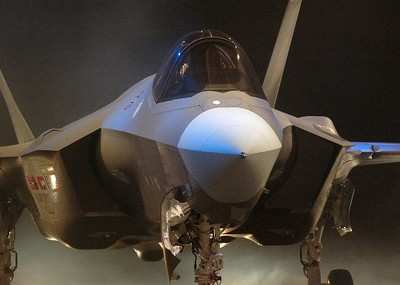Second Failure Surprises Engineers
A cracked turbine blade in the Pratt & Whitney F135 turbofan
destined for installation in the second F-35 joint strike fighter
test aircraft has raised new concerns about the JSF program, though
the manufacturer maintains a fix is in the works.

The Fort Worth (TX) Star-Telegram reports the crack was
discovered Monday, following ground tests on the engine slated for
installation in the first short-takeoff/vertical landing (STOVL)
F-35B variant within the next month.
Pratt & Whitney believes the problem is due to unforeseen
stress on the turbine compressor blades on the uprated STOVL
variant of the engine. A similar problem was uncovered during tests
on the same engine last year; after that failure, Pratt &
Whitney went to work on redesigned turbine blades, slated to come
online this summer.
In the meantime, the enginemaker implemented a series of tests
to determine when the problem could reoccur. Engineers thought they
had a handle on the problem... until Monday's failure.
"It's not a new issue. It's disappointing we didn't notice it
until the part cracked," said Bill Gostic, vice president for F135
engine programs at Pratt & Whitney. Gostic added engineers
think the problem is isolated to the STOVL variant (shown below),
in which a drive shaft from the turbine is connected to a large,
downward-facing ducted fan to provide vertical light on takeoff and
landing. The drive shaft places additional stress to the blade
disc, and the turbine blades.

On Friday, a senior official at Lockheed Martin, manufacturer of
the F-35, told the Star-Telegram initial flight testing of the
second F-35 shouldn't be delayed for long, based on discussions
this week with Pratt & Whitney. First flight is targeted for
late June.
"Our plan all along was to fly conventional first," said Dan
Crowley, Lockheed's executive vice-president for the F-35. Initial
testing of the aircraft's STOVL capabilities isn't scheduled until
early next year -- by which time the blade fix should be in
place.
"It’s the purpose of the development program to run these
kinds of tests and find these problems," he added.
If such a blade failure occurred in flight, the results could be
catastrophic. Of far greater concern to the F-35 program in the
short term, however, are the ramifications of the failure at a time
when lawmakers and Pentagon officials alike have the F-35 in their
cost-cutting crosshairs.
The F-35 is the Pentagon's most expensive single weapons
development project. Its estimated pricetag of at least $299
billion is almost twice that of the next priciest program.
If flight tests are delayed due to the blade failure, opponents
could point to that lack of progress as justification for
drastically scaling back the program. Adding to the turmoil is the
likelihood one of the fiercest JSF proponents, Deputy Defense
Secretary Robert England, will likely leave office by the time a
new presidential administration takes office next January.

News of the problems also gives added ammunition to those
calling for a second engine choice for the F-35. As ANN reported earlier this
week, funding for development of the General
Electric/Rolls Royce F136 was stricken from President Bush's fiscal
year 2009 budget plan, the third year in a row the Bush
administration has pushed to axe the project.
In each of the previous years, funding was restored in
Congress.
 ANN's Daily Aero-Term (05.01.24): Say Altitude
ANN's Daily Aero-Term (05.01.24): Say Altitude ANN's Daily Aero-Linx (05.01.24)
ANN's Daily Aero-Linx (05.01.24) Classic Aero-TV: Korean War Hero Twice Reborn
Classic Aero-TV: Korean War Hero Twice Reborn Airborne 04.29.24: EAA B-25 Rides, Textron 2024, G700 Deliveries
Airborne 04.29.24: EAA B-25 Rides, Textron 2024, G700 Deliveries Airborne Affordable Flyers 05.02.24: Bobby Bailey, SPRG Report Cards, Skydive!
Airborne Affordable Flyers 05.02.24: Bobby Bailey, SPRG Report Cards, Skydive!





